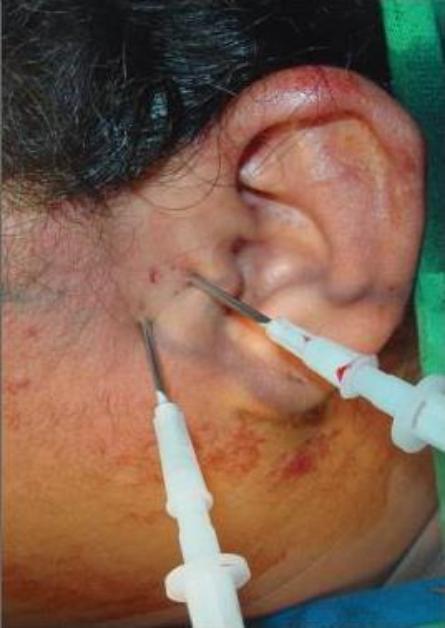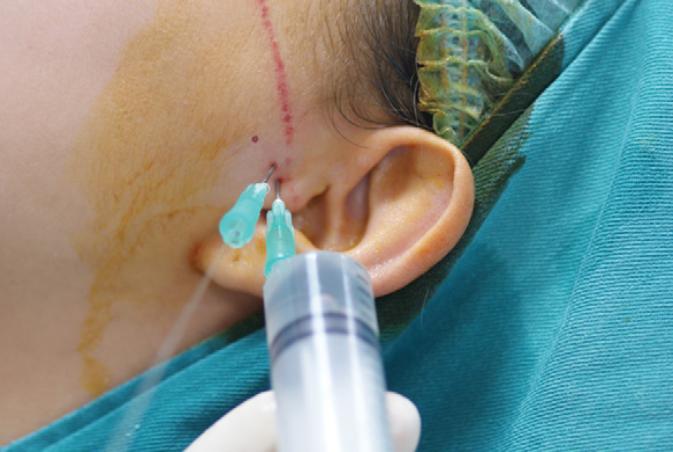TMJ Arthrocentesis (Jaw Joint Washout)
What is Jaw Joint Arthrocentesis?
TMJ / Jaw Joint Arthrocentesis (the washing out of the jaw joint space) is a procedure during which the jaw joint is washed out with sterile saline ± anti-inflammatory steroids, long-acting local anæsthetics, painkillers or collagen components.
TMJ / Jaw Joint Arthrocentesis of the (upper) joint space reduces jaw joint pain by:
- diluting / flushing out the inflammatory chemicals from the jaw joint
- increasing mandibular (lower jaw) movements by removing intra-articular adhesions (scarring within the joint space)
- eliminating the negative pressure within the jaw joint
- recovering disc and fossa space and improving disc mobility (return the disc of cartilage to its normal position within the joint) which reduces the mechanical obstruction caused by the anterior (forward) position of the disc.
The majority of restricted opening is secondary to upper joint space problems, particularly ‘anchored disc’ phenomenon, where arthrocentesis is particularly beneficial.
When is Jaw Joint Arthrocentesis used?
Indications for arthrocentesis are:
- dislocation of the articular disc ± reduction
- limitations of mouth opening originating in the jaw joint
- joint pain and other internal derangements of the TMJ.
What does the treatment involve?
TMJ / Jaw Joint Arthrocentesis usually takes place under a General Anæsthetic – this means you will be asleep for the entire procedure. Whilst you are asleep, two small needles will be inserted into the TMJ / Jaw Joint. One of these needles allows sterile saline to be pumped into the joint under pressure whilst the other needle allows the saline to drain out of the joint.
While you are asleep, your lower jaw will often be Joint disc back into its normal position and break down any adhesions within the jaw joint.
How will I feel after the operation?
The area in and around the TMJ / Jaw Joint is often uncomfortable for several days after the procedure.
You may find it necessary to take simple painkillers, such as Ibuprofen, during this time.
There will be some swelling in front of your ear.
You may also find it difficult to open your jaw for a few weeks.
Will I need another appointment?
You will need to return a few weeks after surgery to have your jaw joint checked by your surgeon. TMJ / Jaw Joint arthrocentesis is not always successful and even in those people who have an improvement following the procedure, it can take several months for this to occur.
Also, you will need to continue with TMJ / Jaw Joint exercises, physiotherapy, wearing of BRA’s etc.
Rare complications include:
- Horner syndrome
- Upper airway compression
- Para-pharyngeal swelling
- Variant petro-tympanic fissure
- Infection of the infra-temporal space
- Pseudo-aneurysm and arterio-venous fistula
- Superficial temporal artery aneurysm
- Trans-articular perforation
- Intra-cranial perforation & extra-dural haematoma
What are the possible complications?
Complications after puncture of the TMJ depend on the anatomy of the joint and its relations.
Possible complications of TMJ / Jaw Joint Arthrocentesis also depend on the technique used. The complication rate following TMJ / Jaw Joint Arthrocentesis is given as between 2 – 10%.
Complications usually present in the immediate post-operative phase and are mostly associated with fluid collection and vascular injury.
Facial Muscle Weakness (< 1.0%) (temporary / permanent) resulting from injury to the Facial Nerve whilst gaining access to the jaw joint space. The most common problem resulting from this, is the inability to wrinkle the brow, raise the eyebrow or gain tight closure of the eyelids.
Numbness (< 2.5%) (temporary / permanent) of certain areas of skin in the region of the jaw joint and sometimes in more remote areas of the face or scalp.
Bleeding within the jaw joint which cannot be adequately controlled and could require immediate intervention by open joint surgery.
Ear problems (< 9.0%), including inflammation of the ear canal, middle / inner ear infections, vertigo, perforation of the ear-drum and temporary / permanent hearing loss.
Instrument Separation (that is, the needle breaks off within the joint space) which may require open joint surgery.
Facial Scarring from the entry injection.
Damage to the jaw joint surface during the arthrocentesis procedure, usually of a reversible nature but which could permanently affect joint function.
Unsuccessful entry into the jaw joint or inability to accomplish the desired procedure because of limited motion of the jaw joint / scarring.
Worsening of present TMJ symptoms which may require repeat arthrocentesis, arthroscopy or open joint surgery.
Changes in the bite after arthrocentesis which may affect chewing functions. In addition, there may be temporary / permanent limited mouth opening.
Post-operative infection requiring additional treatment.
Adverse / Allergic reactions to any of the medications used in the procedure.
Pre-Auricular Hæmatoma. A blood clot can develop infront of the ear.
Extravasation of fluid from the jaw joint into the surrounding tissues.
Useful Articles & Websites
Cochrane Database of Systematic Reviews 2003. Hyaluronate for Temporomandibular Joint Disorders.
BJOMS 2009. Technical note. Single Needle Arthrocentesis.
BJOMS 2010. Review. A Review of Techniques of Lysis and Lavage of the TMJ.
Cochrane Database Syst Rev 2011. Arthroscopy for treating temporomandibular joint disorders




